Exploring the Potential of Carbon Capture, Utilization, and Storage in Baltic Sea Region Countries: A Review of CCUS Patents from 2000 to 2022
Abstract
1. Introduction
- Site selection: Identifying a suitable location for carbon capture and storage (CCS) is an important first step. This may involve evaluating factors such as the geology of the area, the proximity to point sources of CO2, and the availability of infrastructure for transportation and storage.
- Capture technology: There are a variety of technologies that can be used to capture CO2 from the atmosphere or from point sources such as power plants and factories. These technologies include chemical absorption, membrane separation, and cryogenic separation.
- Transport: Once CO2 is captured, it must be transported to a storage site. This can be done by truck, train, or pipeline, depending on the location of the storage site and the volume of CO2 being transported.
- Storage: The captured CO2 is injected into a suitable underground formation, such as a saline aquifer or depleted oil or gas reservoir, for permanent storage.
- Monitoring and verification: It is important to monitor and verify that the CO2 remains stored in the underground formation to ensure that it is not released back into the atmosphere. This may involve using monitoring equipment and conducting periodic checks to ensure that the CO2 is being stored safely and securely.
2. CO2 Capture Technologies: An Overview
3. CO2 Usage Technologies: An Overview
- CO2 chemicals: CO2 can be used as a feedstock to produce chemicals such as methanol, formic acid, and urea. These chemicals have a variety of industrial and consumer applications, including the production of plastics, solvents, and fertilizers.
- CO2 fuels: CO2 can be used to produce fuels such as syngas and methanol, which can be burned to generate energy. These fuels can be produced from CO2 through processes such as carbon capture and utilization (CCU) or carbon capture and storage (CCS).
- Microalgae: Microalgae are tiny aquatic organisms that can be used to produce biofuels and other products. They can absorb CO2 from the air and convert it into biomass through photosynthesis.
- Concrete building materials: CO2 can be used to produce low-carbon concrete building materials, which can reduce the carbon footprint of the construction industry.
- CO2-enhanced oil recovery (EOR): CO2 can be injected into depleted oil reservoirs to help extract remaining oil, a process known as enhanced oil recovery (EOR). This can help extend the life of oil fields and reduce the need for new oil exploration.
- Bioenergy with carbon capture and storage: Bioenergy with carbon capture and storage (BECCS) involves using biomass to generate energy and capturing the CO2 emissions produced in the process. The CO2 can then be stored underground to mitigate climate change.
- Soil carbon sequestration: Soil carbon sequestration involves storing CO2 in the soil through practices such as reducing tillage, adding organic matter, and planting cover crops. This can help reduce CO2 in the atmosphere and improve soil health.
- Biochar: Biochar is produced by “pyrolyzing” biomass, which is plant material that has been burned at high temperatures in a low-oxygen environment. When applied to agricultural soils, biochar has the potential to increase crop yields by 10%. However, it can be difficult to consistently produce a high-quality biochar product or predict how it will react with different soils. We estimate that biochar could utilize 0.2 to 1 Gt of CO2 in 2050, at costs of approximately $65 per ton of CO2.
4. Patent Search Methodology
5. Patent Classification Scheme
- Capture—The CO2 is separated from other gases produced in industrial processes, such as those at coal and natural-gas-fired power generation plants, or steel or cement factories.
- Transport—The CO2 is then compressed and transported via pipelines, road transport or ships to a site for storage.
- Storage—Finally, the CO2 is injected into rock formations deep underground for permanent/temporary storage.
- Utilization—The carbon captured could be re-used in industrial processes by converting it into, for example, plastics, concrete, or biofuel.
6. Patent Landscape Trends—Non-Technology Trends
6.1. Patent Filing Trend across Baltic Sea Region Countries
6.2. Top Assignees
7. Patent Landscape Trends—Technology Trends
8. Investment Trend for Key Players
9. Challenges ahead in CCUS
- Cost: CCUS technologies are currently expensive to implement, which limits their widespread adoption.
- Scale: CCUS technologies are still in the early stages of development and have not yet been deployed at a large scale. This makes it difficult to demonstrate their feasibility and effectiveness.
- Infrastructure: Implementing CCUS technologies often requires significant infrastructure investments, such as pipelines and storage facilities.
- Public acceptance: There is often resistance to CCUS technologies due to concerns about their potential impacts on the environment and communities.
- Legal and regulatory frameworks: CCUS technologies are regulated by a patchwork of laws and regulations that can vary from place to place. This can create uncertainty and make it difficult to advance the deployment of these technologies.
- Technological challenges: There are ongoing efforts to improve the efficiency and effectiveness of CCUS technologies, but there are still technological challenges that need to be addressed in order to make them more viable.
- Competition with other technologies: CCUS technologies face competition from other technologies that aim to reduce greenhouse gas emissions, such as renewable energy and energy efficiency measures.
10. CO2 Leakage Hazards
- Environmental impacts: CO2 is a greenhouse gas, and if it leaks into the atmosphere it can contribute to global warming and climate change.
- Human health impacts: If CO2 leaks into the air, it can displace oxygen and cause respiratory problems in humans and other animals.
- Property damage: CO2 leaks can cause damage to buildings and infrastructure, particularly if the CO2 accumulates in enclosed spaces.
11. Regulatory and Policy Issues for CCUS
12. The Future of CCUS
13. Summary and Conclusions
- A review of Carbon capture utilization and storage potential in Baltic Sea Region (BSR) Countries have been presented.
- The patent landscape search has been conducted to identify patents related to Carbon capture and sequestration.
- The search has been conducted for Lithuania (LT) OR Latvia (LV) OR Estonia (EE) OR Finland (FI) OR Denmark (DK) OR Sweden (SE) OR Russia (RU) OR Poland (PL) OR Norway (NO) OR Iceland (IS) OR Spain (ES) and restricted with earlier Priority date from 2000 to 2020.
- Patents primarily focused on CO2 storage, monitoring, utilization, and transport.
- Identified 497 patents as relevant to CCUS (capture, storage, utilization, and transport).
- Observed decreased priority filing activity from 2004 onwards. High filing rates observed in 2009 and 2011; 2009 has the greatest number of IP activity for CCUS.
- Russia (RU) has the highest number of publications followed by Poland (PL) and Norway (NO).
- A sudden surge in patent filing in Russia since 2007 onwards. Continued interest in patent filing is due to increased application-based industries coming up in the region.
- 2019 has the lowest number of granted patents and 2016 has the lowest number of filings.
- 50% of the relevant patents are for CO2 capture.
- 85% of 497 relevant INPADOC families is alive. Russia (RU) has the greatest number of alive patents.
- Russia (RU) has the greatest number of patents/publications in CO2 capture, storage and utilization/transport followed by Poland (PL) and Norway (NO).
- GE has the highest number of publications followed by Mitsubishi and Siemens.
- CO2 capture is the most explored technology/CCUS type. Capture technology has been prominent from 2003 to 2013.
- Observed capture technology has the greatest number of patents/publications, general and post combustion being the top category followed by Oxyfuel.
- CO2 separation/extraction and CO2 from gas/flue gas is the most prominent in all the divisions.
- Y02C is the top CPC, which is related to CAPTURE, STORAGE, SEQUESTRATION OR DISPOSAL OF GREENHOUSE GASES and followed by B01D, which is related to Separation.
Author Contributions
Funding
Data Availability Statement
Acknowledgments
Conflicts of Interest
Nomenclature
| Country codes | |
| RU | Russia |
| PL | Poland |
| NO | Norway |
| DK | Denmark |
| SE | Sweden |
| FI | Finland |
| ES | Spain |
| IS | Iceland |
| LT | Lithuania |
| LV | Latvia |
| EE | Estonia |
| EP | Europe |
| US | United States of America |
| CA | Canada |
| CN | China |
| Type | Overview |
| Publication Countries | Countries where the patents have been published |
| Patent Family | A patent family is the same invention disclosed by a common inventor(s) and patented in more than one country. |
| Earliest priority date | Earliest priority date is the first filing date within a family of patent applications |
| INPADOC | Stands for International Patent Documentation, is an international patent collection. The database is produced and maintained by the European Patent Office (EPO). It contains patent families and legal status information, and is updated weekly. |
| CPC | The Cooperative Patent Classification (CPC) is a patent classification system, which has been jointly developed by the European Patent Office (EPO) and the United States Patent and Trademark Office (USPTO). |
References
- Gibbins, J.; Chalmers, H. Carbon capture and storage. Energy Policy 2008, 36, 4317–4322. [Google Scholar] [CrossRef]
- Ma, J.; Li, L.; Wang, H.; Du, Y.; Ma, J.; Zhang, X.; Wang, Z. Carbon Capture and Storage: History and the Road Ahead. Engineering 2022, 14, 33–43. [Google Scholar] [CrossRef]
- Martin, B.; Fayers, F.J.; Orr, F.M. Carbon dioxide in enhanced oil recovery. Energy Convers. Manag. 1993, 34, 1197–1204. [Google Scholar] [CrossRef]
- Mikhelkis, L.; Govindarajan, V. Techno-Economic and Partial Environmental Analysis of Carbon Capture and Storage (CCS) and Carbon Capture, Utilization, and Storage (CCU/S): Case Study from Proposed Waste-Fed District-Heating Incinerator in Sweden. Sustainability 2020, 12, 5922. [Google Scholar] [CrossRef]
- English, J.M.; English, K.L. An Overview of Carbon Capture and Storage and its Potential Role in the Energy Transition. First Break 2022, 40, 35–40. [Google Scholar] [CrossRef]
- Chen, S.; Liu, J.; Zhang, Q.; Teng, F.; McLellan, B.C. A critical review on deployment planning and risk analysis of carbon capture, utilization, and storage (CCUS) toward carbon neutrality. Renew. Sustain. Energy Rev. 2022, 167, 112537. [Google Scholar] [CrossRef]
- Hasan, M.M.F.; First, E.L.; Boukouvala, F.; Floudas, C.A. A multi-scale framework for CO2 capture, utilization, and sequestration: CCUS and CCU. Comput. Chem. Eng. 2015, 81, 2–21. [Google Scholar] [CrossRef]
- Gupta, S.; Li, L. The Potential of Machine Learning for Enhancing CO2 Sequestration, Storage, Transportation, and Utilization-based Processes: A Brief Perspective. JOM 2022, 74, 414–428. [Google Scholar] [CrossRef]
- Yao, P.; Yu, Z.; Zhang, Y.; Xu, T. Application of machine learning in carbon capture and storage: An in-depth insight from the perspective of geoscience. Fuel 2022, 333, 126296. [Google Scholar] [CrossRef]
- Thanh, H.V.; Zamanyad, A.; Safaei-Farouji, M.; Ashraf, U.; Hemeng, Z. Application of hybrid artificial intelligent models to predict deliverability of underground natural gas storage sites. Renew. Energy 2022, 200, 169–184. [Google Scholar] [CrossRef]
- Safaei-Farouji, M.; Thanh, H.V.; Dai, Z.; Mehbodniya, A.; Rahimi, M.; Ashraf, U.; Radwan, A.E. Exploring the power of machine learning to predict carbon dioxide trapping efficiency in saline aquifers for carbon geological storage project. J. Clean. Prod. 2022, 372, 133778. [Google Scholar] [CrossRef]
- Safaei-Farouji, M.; Thanh, H.V.; Dashtgoli, D.S.; Yasin, Q.; Radwan, A.E.; Ashraf, U.; Lee, K.K. Application of robust intelligent schemes for accurate modelling interfacial tension of CO2 brine systems: Implications for structural CO2 trapping. Fuel 2022, 319, 123821. [Google Scholar] [CrossRef]
- Rodriguez, E.; Lefvert, A.; Fridahl, M.; Grönkvist, S.; Haikola, S.; Hanssona, A. Tensions in the Energy Transition: Swedish and Finnish Company Perspectives on Bioenergy with Carbon Capture and Storage. J. Clean. Prod. 2021, 280, 124527. Available online: https://www.sciencedirect.com/science/article/pii/S0959652620345716 (accessed on 18 October 2022). [CrossRef]
- Krumins, J.; Kļaviņš, M.; Ozola-Davidāne, R.; Ansone-Bērtiņa, L. The Prospects of Clay Minerals from the Baltic States for Industrial-Scale Carbon Capture: A Review. Minerals 2022, 12, 349. [Google Scholar] [CrossRef]
- Śliwińska, A.; Strugała-Wilczek, A.; Krawczyk, P.; Leśniak, A.; Urych, T.; Chećko, J.; Stańczyk, K. Carbon Capture Utilisation and Storage Technology Development in a Region with High CO2 Emissions and Low Storage Potential—A Case Study of Upper Silesia in Poland. Energies 2022, 15, 4495. Available online: https://www.mdpi.com/1996-1073/15/12/4495 (accessed on 18 October 2022). [CrossRef]
- Shogenova, A.; Nordback, N.; Sopher, D.; Shogenov, K.; Niemi, A.; Juhlin, C.; Sliaupa, S.; Ivandic, M.; Wojcicki, A.; Ivask, J.; et al. Carbon Neutral Baltic Sea Region by 2050: Myth or Reality? In Proceedings of the 15th Greenhouse Gas Control Technologies Conference, Abu Dhabi, UAE, 15–18 March 2021; Available online: https://www.researchgate.net/publication/350608283_Carbon_Neutral_Baltic_Sea_Region_by_2050_Myth_or_Reality (accessed on 18 October 2022).
- Adlen, E.; Hepburn, C. 10 Carbon Capture Methods Compared: Costs, Scalability, Permanence and Cleanness. Carbon Brief Energypostevents. 11 November 2019. Available online: https://energypost.eu/10-carbon-capture-methods-compared-costs-scalability-permanence-cleanness/ (accessed on 18 October 2022).
- Shogenova, A.; Šliaupa, S.; Shogenov, K.; Vaher, R.; Šliaupienė, R. Geological Storage of CO2—Prospects in the Baltic States. In Proceedings of the 69th EAGE Conference and Exhibition, Incorporating SPE EUROPEC, London, UK, 11–14 June 2007. [Google Scholar]
- Jansons, L.; Zeltins, N. Technical studies on development of the Dobele underground natural gas storage facility. In Proceedings of the REHVA Annual Conference, Riga, Latvia, 8–9 May 2015. [Google Scholar]
- Šliaupienė, R.; Šliaupa, S. Prospects of CO2 geological storage in deep saline aquifers of Lithuania and adjacent territories. Geologija 2011, 53, 121–133. [Google Scholar] [CrossRef]
- Bazhenov, S.; Chuboksarov, V.; Maximov, A.; Zhdaneev, O. Technical and Economic Prospects of CCUS Projects in Russia. Sustain. Mater. Technol. 2022, 33, e00452. Available online: https://www.sciencedirect.com/science/article/abs/pii/S2214993722000665 (accessed on 18 October 2022). [CrossRef]
- Jafri, Y.; Ahlstrom, J.M.; Furusjo, E.; Harvey, S.; Pettersson, K.; Svensson, E.; Wetterlund, E. Double Yields and Negative Emissions Resource, Climate and Cost Efficiencies in Biofuels with Carbon Capture, Storage and Utilization. Front. Energy Res. 2022, 10, 797529. [Google Scholar] [CrossRef]
- Zhang, L.; Song, Y.; Shi, J.; Shen, Q.; Hu, D.; Gao, Q.; Chen, W.; Kow, K.W.; Pang, C.; Sun, N.; et al. Frontiers of CO2 Capture and Utilization (CCU) Towards Carbon Neutrality. Adv. Atmos. Sci. 2022, 39, 1252–1270. Available online: https://link.springer.com/article/10.1007/s00376-022-1467-x (accessed on 18 October 2022). [CrossRef]
- Deng, Q.; Ling, X.; Zhang, K.; Tan, L.; Qi, G.; Zhang, J. CCS and CCUS Technologies: Giving the Oil and Gas Industry a Green Future. Front. Energy Res. 2022, 10, 919330. [Google Scholar] [CrossRef]
- Sokołowski, A.; Brulińska, D.; Sokołowska, E. Multimarker Response of the Ragworm Hediste Diversicolor (Polychaeta) to Seawater Acidification Derived from Potential CO2 Leakage from the CCS Sub-Seabed Storage Site in the Baltic Sea. J. Exp. Marone Biol. Ecol. 2020, 530–531, 151433. Available online: https://www.sciencedirect.com/science/article/abs/pii/S0022098119303788 (accessed on 18 October 2022). [CrossRef]
- Yin, C.; Yan, J. Oxy-Fuel Combustion of Pulverized Fuels: Combustion Fundamentals and Modeling. Appl. Energy 2016, 162, 742–762. [Google Scholar] [CrossRef]
- Stigson, S.; Haikola, S.; Hansson, A. Work Package 3—Social Aspects for Baltic Sea Storage of Carbon Dioxide. A Case Study Report. Elforsk 2015, 1–21. Available online: https://www.globalccsinstitute.com/archive/hub/publications/190038/ccs-baltic-sea-region-bastor2-work-package-3-social-aspects.pdf (accessed on 18 October 2022).
- Biniek, K.; Henderson, K.; Rogers, M.; Santoni, G. The Future of CCUS: New Technologies that Fight Climate Change with Captured CO2. RECHARGE: Global News and Intelligence foe the Energy Transition. 2020. Available online: https://www.rechargenews.com/transition/the-future-of-ccus-new-technologies-that-fight-climate-change-with-captured-co2/2-1-861191 (accessed on 18 October 2022).
- Salvi, B.L.; Jindal, S. Recent Developments and Challenges Ahead in Carbon Capture and Sequestration Technologies. SN Appl. Sci. 2019, 1, 885. Available online: https://link.springer.com/article/10.1007/s42452-019-0909-2 (accessed on 18 October 2022). [CrossRef]
- Bettenhausen, C. The Life-Or-Death Race to Improve Carbon Capture. Chem. Eng. News 2021, 99, 28–35. Available online: https://cen.acs.org/environment/greenhouse-gases/capture-flue-gas-co2-emissions/99/i26 (accessed on 18 October 2022). [CrossRef]
- Orbit Database. Available online: www.orbit.com (accessed on 18 October 2022).
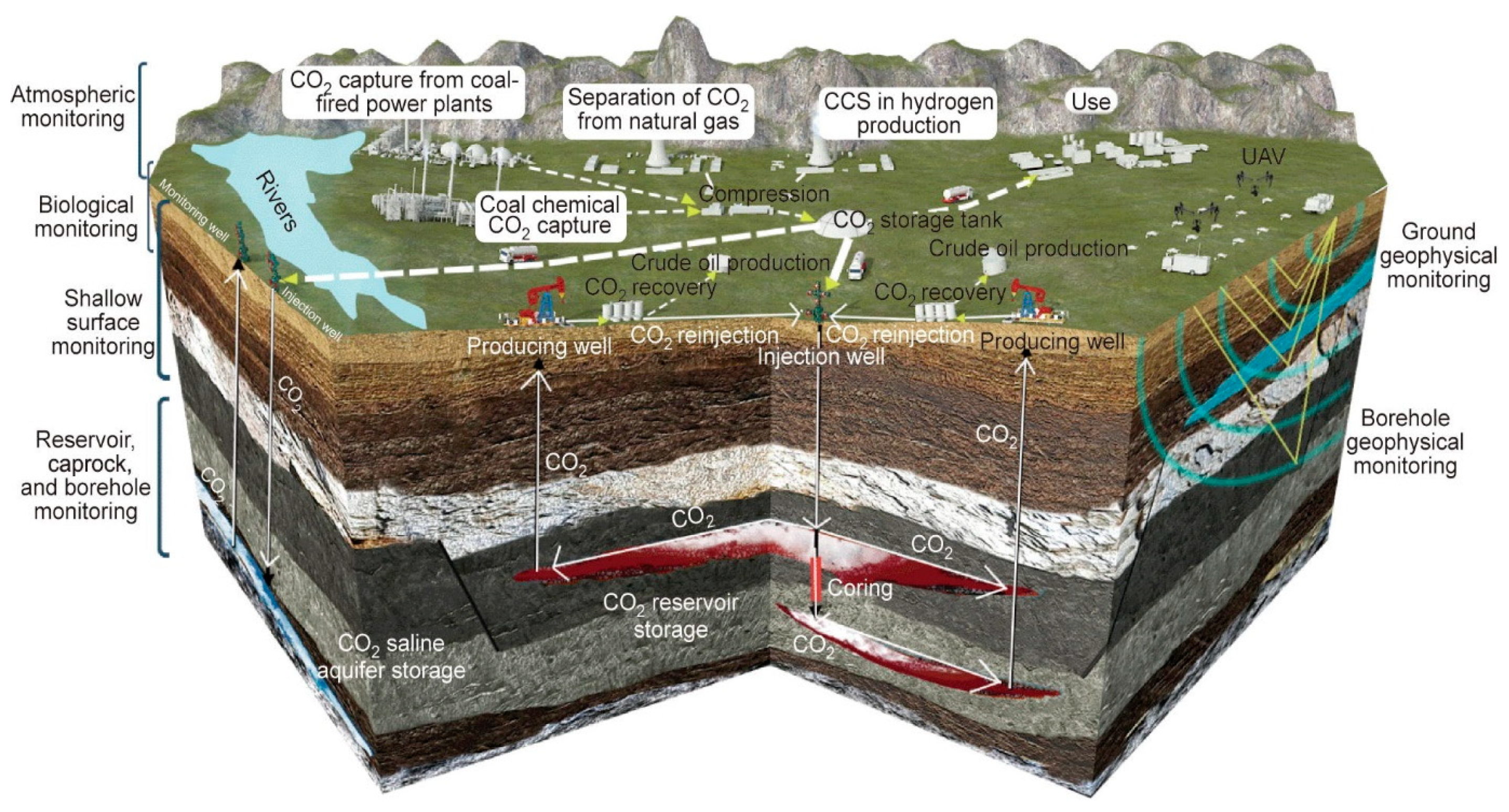

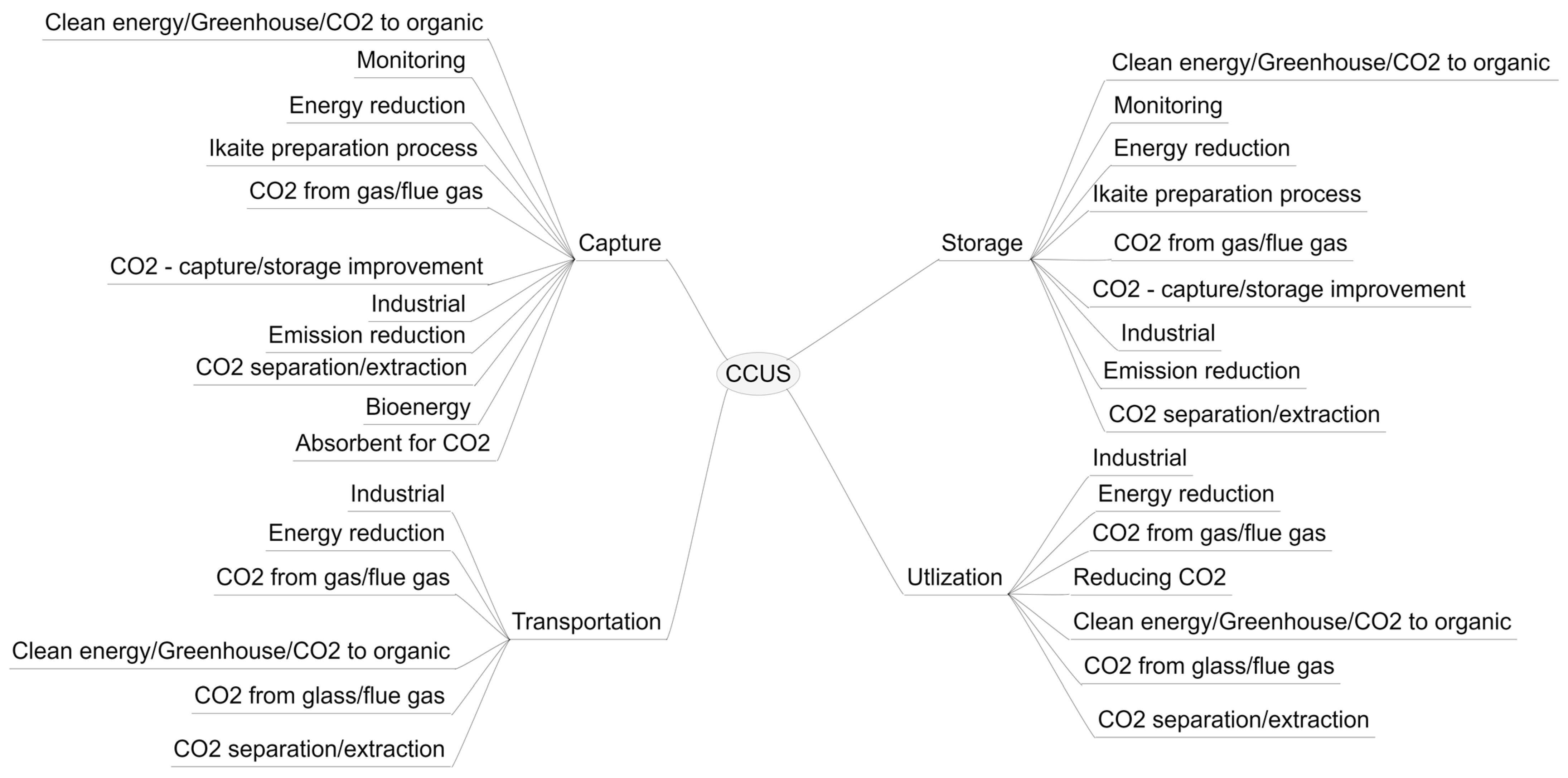

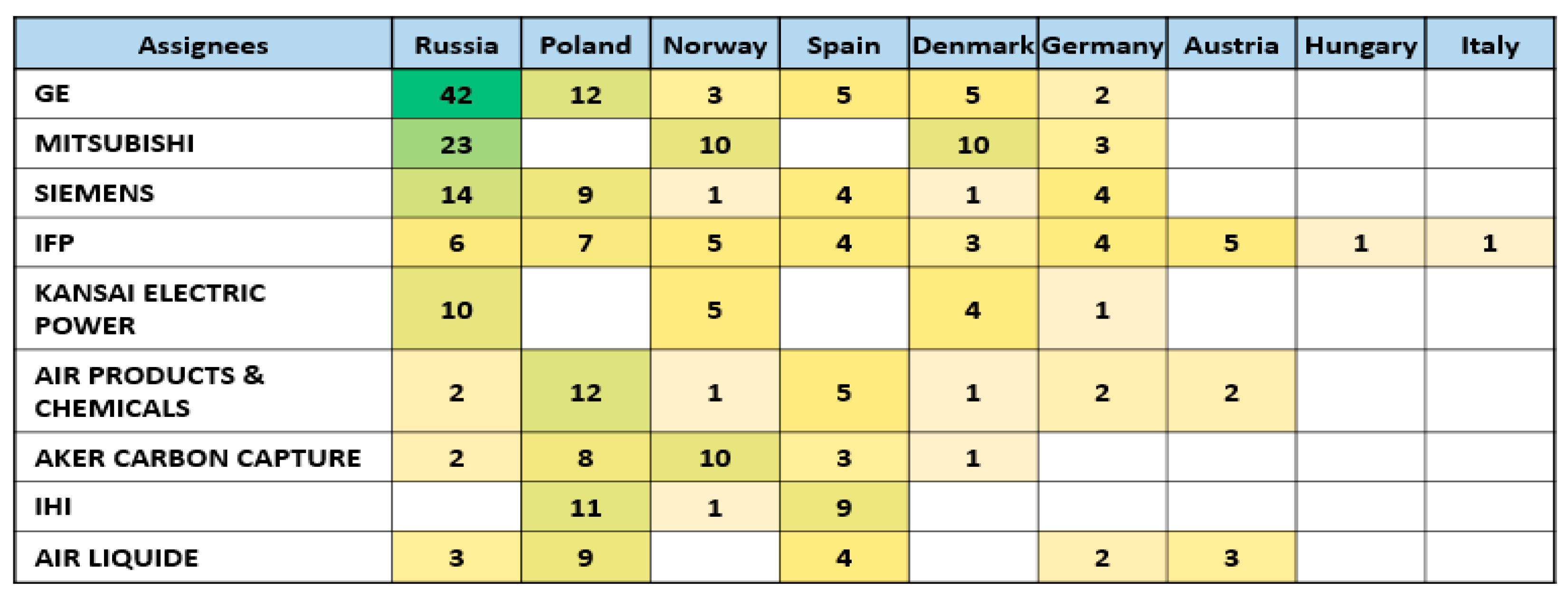
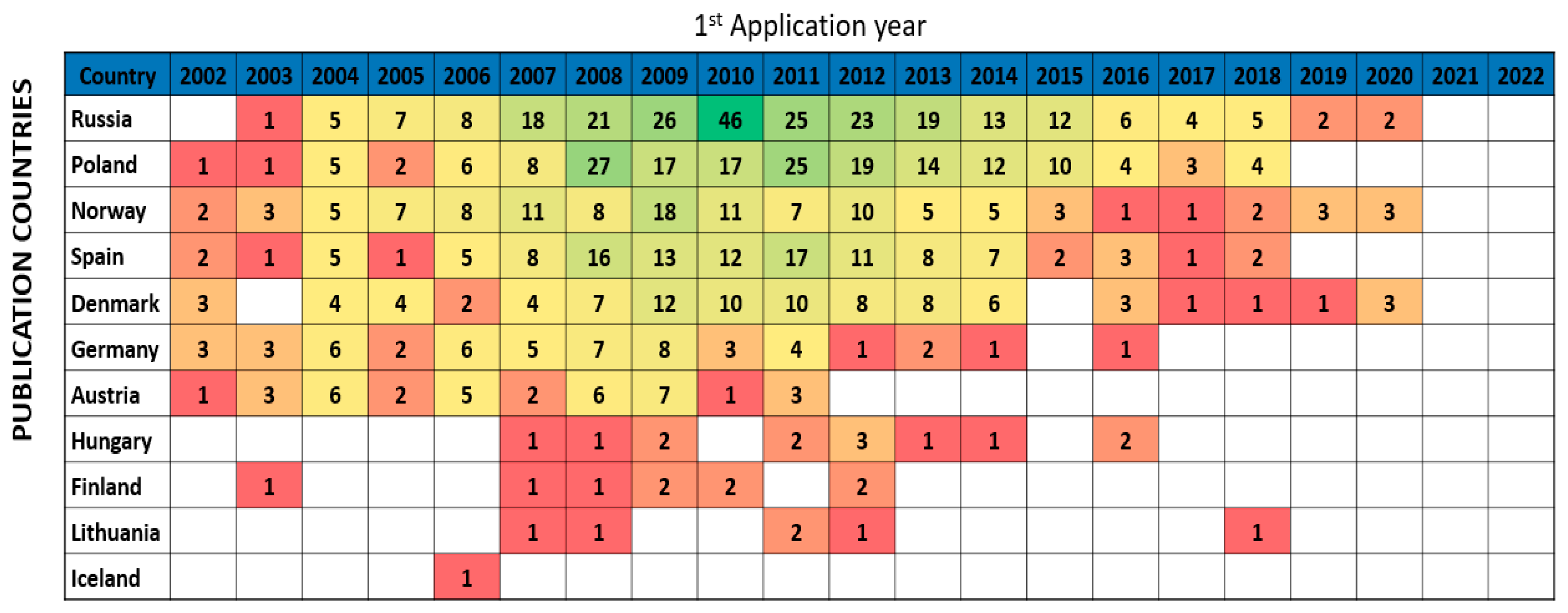

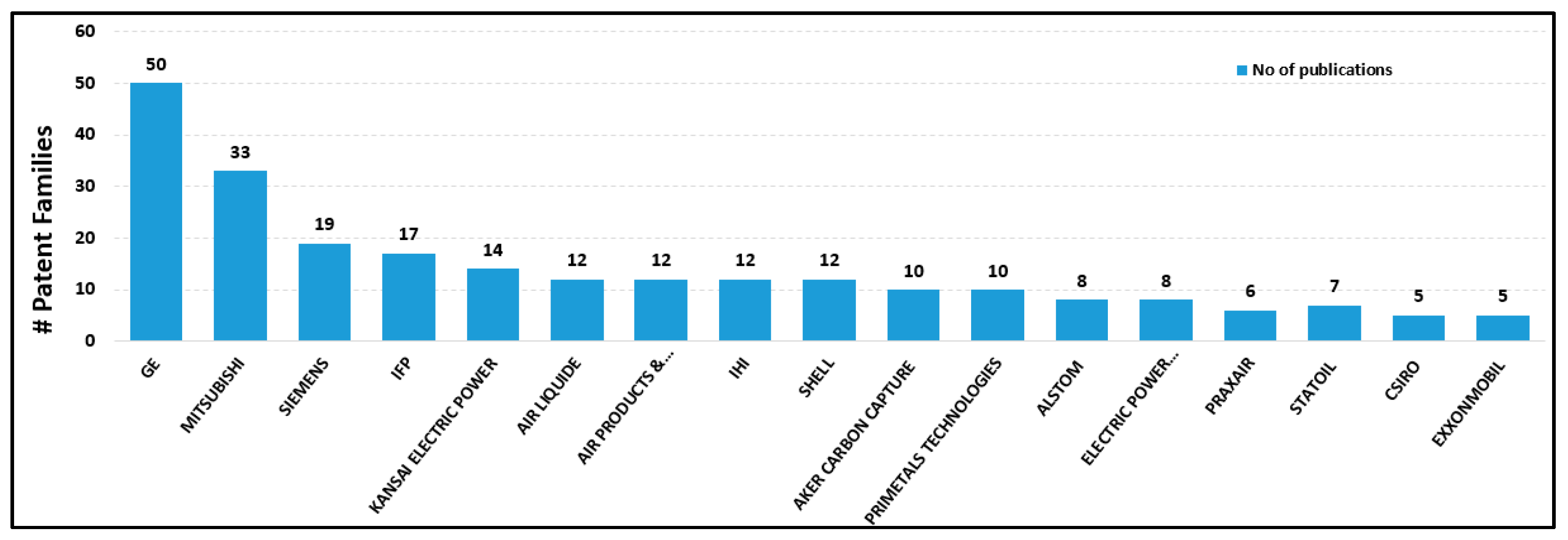

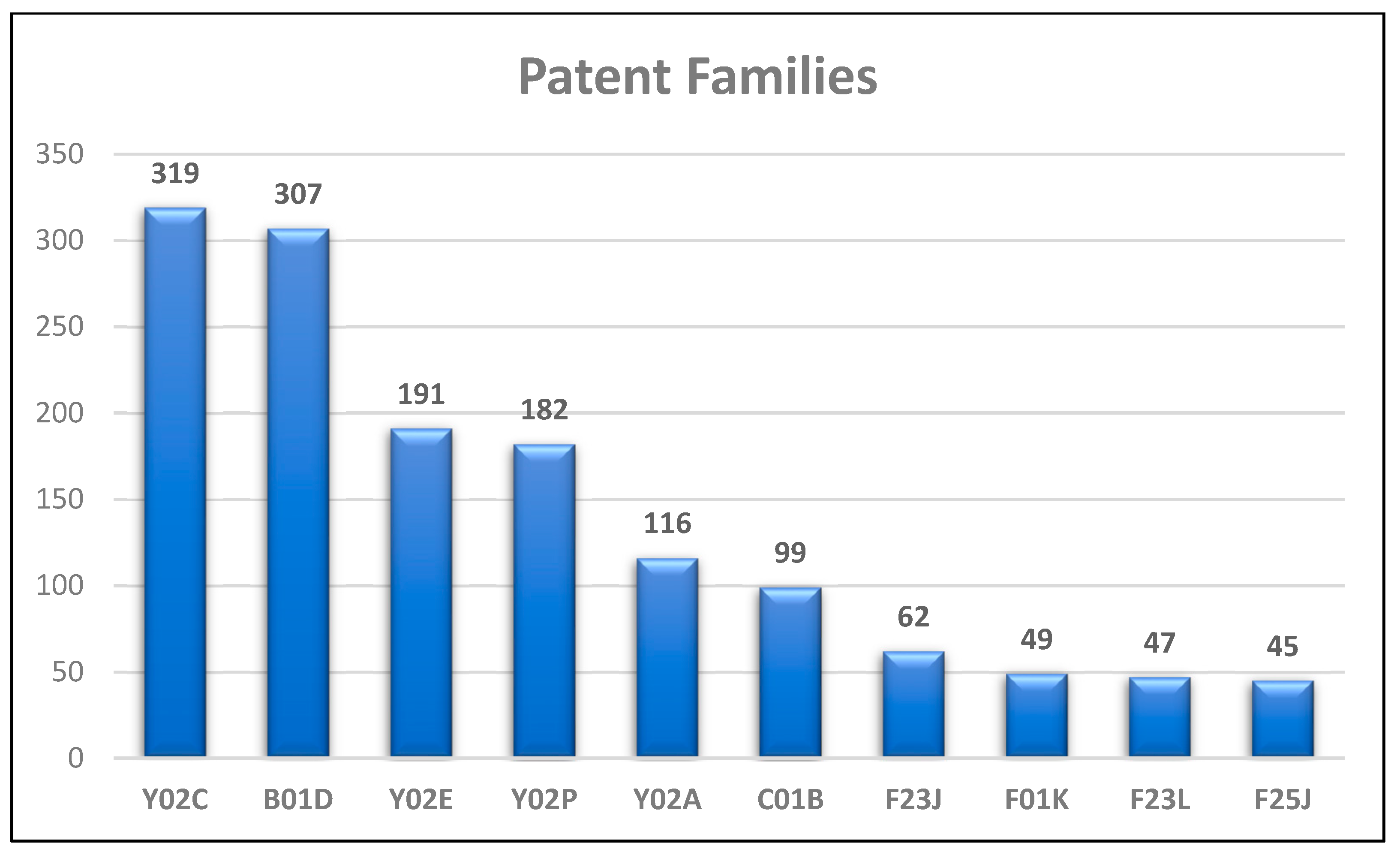





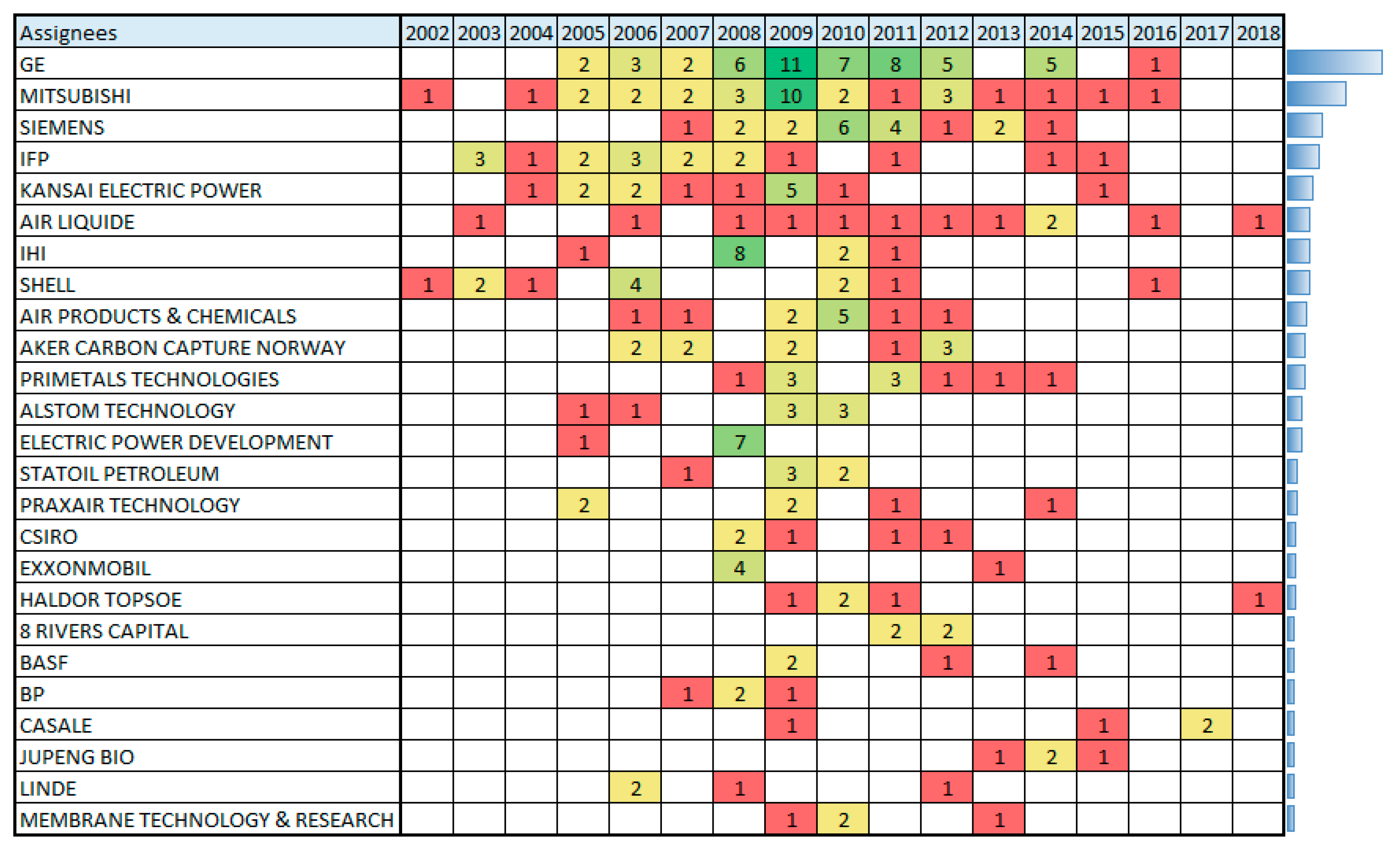
| Capture Technology | Overview | Current Status |
|---|---|---|
| Chemical absorption | Chemical absorption involves the use of a solvent to absorb CO2 from a gas stream, after which the solvent is regenerated and the CO2 is separated. The most commonly used solvents are amines, which react with CO2 to form a stable compound. The CO2 is then released from the solvent by heating. Chemical absorption is a widely used and advanced technology, but it can be energy-intensive and costly. | Chemical absorption is a widely used and advanced technology for CO2 capture. However, it is energy-intensive and costly, and there are ongoing efforts to improve its efficiency and reduce costs. |
| Physical separation | Physical separation technologies, such as cryogenics and adsorption, use the difference in physical properties between CO2 and other gases to separate them. In cryogenic separation, the gas stream is cooled until the CO2 condenses and can be collected. Adsorption technologies use a solid material to trap CO2 from the gas stream, after which the CO2 can be released by heating or pressure change. Physical separation technologies are widely used and advanced, but they can be energy-intensive and costly. | Physical separation technologies are widely used and advanced for CO2 capture. However, they can be energy-intensive and costly, and there are ongoing efforts to improve their efficiency and reduce costs. |
| Oxy-fuel separation | Oxy-fuel separation involves burning a fuel with oxygen instead of air, resulting in a flue gas that is mostly CO2 and water vapor. The CO2 can then be separated from the water vapor by condensation. Oxy-fuel separation is a promising technology, but it is not yet widely used due to technical and economic challenges. | Oxy-fuel separation is a promising technology for CO2 capture, but it is not yet widely used due to technical and economic challenges. There are ongoing efforts to improve its efficiency and reduce costs. |
| Membrane separation | Membrane separation technologies use a semi-permeable membrane to separate CO2 from a gas stream based on the difference in gas permeability. The CO2 is absorbed by the membrane, while other gases pass through. Membrane separation can be more energy-efficient than other technologies, but it is not yet widely used for CO2 capture due to technical and economic challenges. | Membrane separation is a promising technology for CO2 capture, but it is not yet widely used due to technical and economic challenges. There are ongoing efforts to improve its efficiency and reduce costs. |
| Calcium looping | Calcium looping is a variation of chemical looping that uses calcium oxide (CaO) as the solid material for absorbing CO2. The CaO is heated to release the CO2, which can be collected. The CaO is then regenerated by reacting with calcium carbonate (CaCO3), which is abundant and inexpensive. Calcium looping has the potential to be more energy-efficient and cost-effective. | Technology has been tested on some pilot projects. |
| Chemical looping | Chemical looping involves the use of a solid material, such as iron oxide, to absorb CO2 from a gas stream. The solid material is then heated to release the CO2, which can be collected. The solid material is then regenerated and ready to absorb more CO2. Chemical looping has the potential to be more energy-efficient than other technologies, but it is still in the early stages of development. | Technology has been tested on some limited pilot projects |
| Direct separation | Direct air separation involves capturing CO2 directly from the ambient air using an adsorbent material. The CO2 is then released from the adsorbent by heating or pressure change. | Energy intensive process but pilot projects have been in operation in Europe and the USA. |
| Supercritical CO2 power cycles | This technology is still in the early stages of development, with only a few small-scale demonstrations in operation. However, it has the potential to significantly increase the efficiency of power generation compared to traditional thermal power plants, as well as reducing CO2 emissions by capturing and storing the CO2 produced. It is particularly well-suited for use with renewable energy sources, such as solar or nuclear, which produce heat that can be used to drive the supercritical CO2 cycle. | Trigen project developed by Maersk Oil. |
| Sl No | Query | Concept | Result(s) |
|---|---|---|---|
| 1 | ((((Carbon or (carbon d dioxide) or CO2) 3d (captur+ or storage or storing or sequestration or evaluation or trap+ or transport+ or utliz+)) or (ccus or ccs)))/ti/ab/clms/desc/odes/tx | CO2 capture/storage in Full text | 154,439 |
| 2 | Prd ≥ 2000 | Year restriction 2000–2020 | 45,445,454 |
| 3 | (Lt or lv or ee or fi or dk or se or ru or pl or no or is)/pn | Country restriction | 2,611,315 |
| 4 | 1 and 2 and 3 | 7578 | |
| 5 | ((Carbon or (carbon d dioxide) or CO2) 3d (captur+ or stor+ or sequestration or evaluation or trap+ or transport+ or utliz+))/ti/ab/clms/desc/odes/tx | CO2 capture/storage in Full text | 108,111 |
| 6 | 5 and 2 and 3 | CO2 capture/storage in FT and Priority Date and CC | 4564 |
| 7 | (Y02c+ or y02e+ or y02+ or g01n+ or g01v+)/ipc/cpc | Classification | 5,482,625 |
| 8 | 6 and 7 | 2133 | |
| 9 | 4 and 7 | 2783 | |
| 10 | (((Carbon or (carbon d dioxide) or CO2) 3d (captu+ or grab+ or aquir+ or trap+)))/ti/ab/clms | CO2 capture in Title abstract & Claims | 7943 |
| 11 | 10 and 2 and 3 | CO2 capture in Title, abstract & Claims and Priority Date and CC | 399 |
| 12 | ((Carbon or (carbon d dioxide) or CO2) 3d (stor+ or conserv+ or reserv+ or sequestration))/ti/ab/clms | CO2 capture in Title abstract & Claims | 27,727 |
| 13 | 12 and 2 and 3 | CO2 storage in Title, abstract & Claims and Priority Date and CC | 617 |
| 14 | (((Carbon or (carbon d dioxide) or CO2) 3d (transport+ or ship+ or pipe+)))/ti/ab/clms | CO2 Transport in Title abstract & Claims | 44,291 |
| 15 | 14 and 2 and 3 | CO2 Transport in Title abstract & Claims | 843 |
| 16 | (((Carbon or (carbon d dioxide) or CO2) 3d (captur+ or stor+ or sequestration or evaluation or trap+ or transport+ or utliz+)) 5d (monitor+ or surve+ or controll+))/ti/ab/clms/tx | CO2 capture/storage in Full Text with monitoring | 1898 |
| 17 | 16 and 2 and 3 | CO2 capture/storage in Full Text with monitoring and Priority Date and CC | 62 |
| 18 | 11 or 13 or 15 or 17 | 1749 | |
| 19 | 18 or 8 | Without CPC | 3299 |
| 20 | 18 and 7 | 728 | |
| 21 | 20 or 8 | With CPC | 2278 |
| Y02C | capture, storage, sequestration or disposal of greenhouse gases |
| B01D | separation |
| Y02E | reduction of greenhouse gas [ghg] emissions, related to energy generation, transmission or distribution |
| Y02P | climate change mitigation technologies in the production or processing of goods |
| Y02A | technologies for adaptation to climate change |
| C01B | non-metallic elements; compounds thereof |
| F23J | removal or treatment of combustion products or combustion residues; flues |
| F01K | steam engine plants; steam accumulators; engine plants not otherwise provided for; engines using special working fluids or cycles |
| F23L | supplying air or non-combustible liquids or gases to combustion apparatus in general |
| F25J | liquefaction, solidification or separation of gases or gaseous or liquefied gaseous mixtures by pressure and cold treatment |
Disclaimer/Publisher’s Note: The statements, opinions and data contained in all publications are solely those of the individual author(s) and contributor(s) and not of MDPI and/or the editor(s). MDPI and/or the editor(s) disclaim responsibility for any injury to people or property resulting from any ideas, methods, instructions or products referred to in the content. |
© 2023 by the authors. Licensee MDPI, Basel, Switzerland. This article is an open access article distributed under the terms and conditions of the Creative Commons Attribution (CC BY) license (https://creativecommons.org/licenses/by/4.0/).
Share and Cite
Pal, M.; Karaliūtė, V.; Malik, S. Exploring the Potential of Carbon Capture, Utilization, and Storage in Baltic Sea Region Countries: A Review of CCUS Patents from 2000 to 2022. Processes 2023, 11, 605. https://doi.org/10.3390/pr11020605
Pal M, Karaliūtė V, Malik S. Exploring the Potential of Carbon Capture, Utilization, and Storage in Baltic Sea Region Countries: A Review of CCUS Patents from 2000 to 2022. Processes. 2023; 11(2):605. https://doi.org/10.3390/pr11020605
Chicago/Turabian StylePal, Mayur, Viltė Karaliūtė, and Shruti Malik. 2023. "Exploring the Potential of Carbon Capture, Utilization, and Storage in Baltic Sea Region Countries: A Review of CCUS Patents from 2000 to 2022" Processes 11, no. 2: 605. https://doi.org/10.3390/pr11020605
APA StylePal, M., Karaliūtė, V., & Malik, S. (2023). Exploring the Potential of Carbon Capture, Utilization, and Storage in Baltic Sea Region Countries: A Review of CCUS Patents from 2000 to 2022. Processes, 11(2), 605. https://doi.org/10.3390/pr11020605









